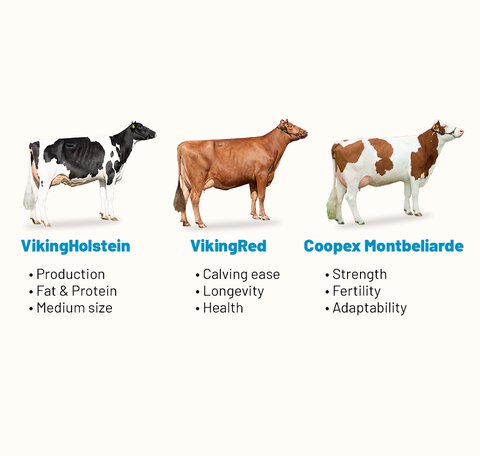When switching from a pure-bred dairy herd to ProCROSS, you don't need to worry about any drop in milk solids production.
The combination of VikingHolstein, VikingRed and Coopex Montbéliarde has proven to be the most profitable cross. The three breeds are unrelated, high-producing and well-suited for the herds adopting all-year-round calving and autumn block-calving systems.
VikingHolstein, VikingRed and Coopex Montbéliarde combine and compensate for their strong and weak points. Each breed has its own efficient breed improvement programme with top-ranking bulls.
With the right combination of breeds, you can achieve significant improvements in lifetime production and, at the same time, reduce the costs and amount of work per cow.
You also get heterosis as an extra benefit on top of the parent average.
Two-way or three-way rotation?
Two-way cross
The simplest model of rotational crossbreeding is the two-way cross where you cross two different cattle breeds. The first generation is called G1. If you mate the offspring from this cross back to one of the original breeds, this is called a backcross.
When using two-way cross, you always get the highest level of heterosis in the first generation. The level decreases in the following generations. When you backcross G1 cows, the heterosis is halved in generation G2 compared to the level in G1. Heterosis rises again in the G3 generation, but then levels to 67% in a few generations.
Three-way cross
With ProCROSS, you get the optimal crossbreeding system as heterosis remains higher in three-way than in two-way crossbreeding.
In three-way crossbreeding, your first generation is also called G1. But instead of starting the backcrossing with the cows, you mate the cows with a third breed.
You typically start with a Holstein cow/heifer and mate her with a VikingRed bull. The heifer resulting from the mating (G1), you mate with a Coopex Montbeliarde bull. The G2 heifer, you mate with a VikingHolstein bull to breed the G3 heifer.
Continue with the rotational system in your mating plan to maintain the optimal level of heterosis. Apply this plan consistently to achieve the best results. After three generations, you will have a homogeneous herd.
The heterosis stays at 100% for the first two generations, but then drops when you mate the first backcrossing with one of the original breeds in the G3 generation. After a few generations, the heterosis level for your ProCROSS herd steadies at 86%.
Four-way cross
With four-way crossbreeding, you can achieve an even higher heterosis, but it becomes more complicated to maintain the correct rotation.
It's harder to find a fourth breed that complements the other three breeds well and are from unrelated populations. Therefore, four-way crossbreeding is not recommended.






